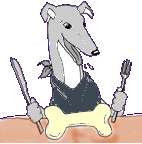As you introduce your greyhound to your home, you will also have to teach him a new concept — that not all food he sees is for him. He’ll need to learn the difference between dog food and people food. A greyhound’s diet at the track consisted of 6-8 cups of quality dry meal/kibble, with 1-2 lb. of meat (sometimes 4-D — diseased, deadly, dying, etc. ) added, and cooked vegetables. In retirement, as a house pet, your new greyhound won’t need that volume of food nor the added meat.
Initial Eating Adjustment
Some greyhounds may seem nervous when eating. They are just worried that someone else is going to come and take their food. My first greyhound would load his mouth up with kibble, go into another room, drop it and then eat it in privacy. He eventually realized the food was his, and he could eat it in peace. Also, they may be very sloppy initially. You’ll find more kibble on the floor than what’s in the bowl. Again, they are chowing down because they are afraid someone else is going to take their food. Eventually, better manners will prevail.
What To Feed
Everyone has their own favorite kibble. I recommend a high-quality kibble (Nature’s Recipe, Nutro-Max, Sensible Choice, etc.) from a pet food store. Grocery stores carry lower grade foods that use corn as a filler. The first few ingredients on the bag should not contain by-products or corn. An additional supplement (Vital Nutrition, Derm-Caps, Missing Link, etc.), whether powder or oil, helps greyhounds coats become sleeker.
Greyhounds generally have excellent appetites and will eat everything. Unfortunately, everything doesn’t quite agree with them. Like most sighthounds, greyhounds have sensitive digestive systems that respond to changes in their diet with diarrhea. So too many table scraps is not necessarily a good idea.
How to Feed
I’ve successfully free fed all of my greyhounds. This means I leave dry food out in their dish 24 hours a day, and they eat when they are hungry. My dogs do not ever get fat, and are not that food oriented because they know they can get food whenever they want. Other greyhound owners feed their greys twice a day, totaling about 4-6 cups of kibble. You may need to modify the amount after the first few weeks according to your dog’s activity level, age, and size. You should be able to feel ribs, not see them.
Greyhounds need their food elevated. You can buy the feeding platforms, or just invert buckets or a box and put your dog’s bowls on them.
Treats
Your greyhound may have eaten bananas, apricots, pumpkin, applesauce, spinach, and even vanilla ice cream as a racer. Oftentimes marshmallows were given after a race. When selecting snacks for your pet, choose good quality basics such as Milkbones and natural biscuits. Avoid treats that contain lots of dye and sugar. Rawhide bones (American only), Nylabones, other toys, and stuffed animals are all treats your greyhound should have. Treats are an excellent positive reinforcement.
You should be perfect about one thing though — CHOCOLATE CAN BE DANGEROUS. Reactions vary from dog to dog, but none are good. Chocolate contains ingredients that can speed your dog’s heart rate and can cause allergic reactions.
Don’t Say You Weren’t Warned
And you must be warned. A greyhound fart will wake you up in the middle of the night, and can clear a room. This flatulence usually occurs because you’ve given him something he’s not used to in his diet, like a new treat or some of your food (!). Or he could have gotten into something in the yard or garbage that didn’t quite agree with him. It could also be a sign that he needs to go out, so let him out! Some people say that giving a greyhound one to two dollops of lowfat, plain yogurt will cause the flatulence to cease.
